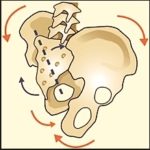Influence of Sacrum during gait cycle….
[vc_row][vc_column][vc_column_text]
Walking is influenced by the ability of the sacrum to torsion left on the left axis and right on the right axis.
Sacral torsional movement is considered to occur around an oblique axis. the left oblique axis runs from the upper extremity of the left sacroiliac joint to the lower end of the right sacroiliac joint, and the right oblique axis runs from the upper end of the right sacroiliac joint to the lower extremity of the left sacroiliac joint.
Clinical observation of the normal walking cycle demonstrates that sacral side-bending and rotation couple to opposite sides. This is also known as ‘Type 1 motion’.
‘Type 2 motion’ is coupling to the same side.
left torsion on the left oblique axis, the sacrum rotates left and side-bends right, with the right sacral base moving into anterior nutation.
right torsion on the right oblique axis, the sacrum rotates right and side-bends left, with the left sacral base moving into anterior nutation.
Because the nutational component of this normal walking movement is anterior in direction, left torsion on the left oblique axis and right torsion on the right oblique axis are described as anterior torsional movements.
The exact biomechanics of the torsional movements of the sacrum are still unknown, The nutational movement in normal walking is anterior on one side, return to neutral, and vice versa.
How sacrum moves during gait cycle?
Right heel strike, the right innominate has rotated in a posterior direction and the left innominate has rotated in an anterior direction. The anterior surface of the sacrum is rotated to the [restrict]left and the superior surface is level.
Right leg moves from heel strike to toe off, when body weight begins to propulse over your right leg, which occurs pelvis to shift laterally to the right. At right leg mid-stance, the right leg is straight and the innominate is rotating anteriorly. The sacrum has rotated right and side-bent left.
The movement continues toward right leg toe off, right pelvic innominate bone begins to rotate anteriorly while left innominate bone begins to rotate posteriorly.
As right innominate rotates anteriorly, sacrum moves into right torsion on the right oblique axis.
Eventually, Lumbar spine side-bends right and rotates left, thoracic spine side-bends left and rotates right and cervical spine side-bends right and rotates right.

Left heel strike, the left innominate begins to rotate anteriorly; after toe-off, the right innominate begins to rotate posteriorly. The sacrum is level, rotated right.
Left leg mid-stance, the left innominate is high, rotating anteriorly, and the left leg is straight. The sacrum has rotated to the left and is side-bent right.
As left innominate rotates anteriorly, your sacrum moves into left torsion on the left oblique axis (i.e., left rotates and right side-bends because the right sacral base moves in anterior nutation).
Left leg moves from weight bearing to toe off, the left innominate, the sacrum, lumbar and thoracics torsion, rotate and side-bend in an opposite manner.
Reference :
1 Kinesiology, North American Edition: The Mechanics and Pathomechanics of Human Movement, (Recall Series) Second, North American Edition.
[/restrict]
Register here to read full content[/vc_column_text][/vc_column][/vc_row]




Leave a Reply
Want to join the discussion?Feel free to contribute!